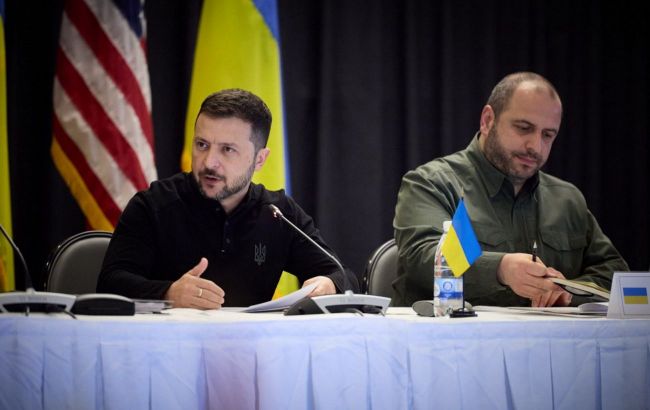Support for Kursk direction: Key takeaways from Ramstein-24 and upcoming arms for Ukraine
 Photo: President Volodymyr Zelenskyy and Defense Minister Rustem Umerov at the Ramstein-24 meeting (president.gov.ua)
Photo: President Volodymyr Zelenskyy and Defense Minister Rustem Umerov at the Ramstein-24 meeting (president.gov.ua)
The 24th meeting of the Ukraine Defense Contact Group in the Ramstein format took place at an American airbase in Germany, for the first time with the participation of President Volodymyr Zelenskyy. During the meeting, allies made several important announcements and promised new arms deliveries.
RBC-Ukraine summarizes the outcomes of Ramstein-24.
Contents
Statements following the Ramstein meeting
At the final briefing, US Defense Secretary Lloyd Austin stated that partners had heard the request for providing security assistance as quickly as possible. It was emphasized that "President Zelenskyy's outrage" regarding Putin's recent actions had been heard, and the consequences of the full-scale invasion had been seen.
According to him, the current situation in the Pokrovsk direction is difficult. However, he praised the Defense Forces for their bravery and resilience, not only within the country.
Austin said that it was necessary to ensure Ukraine received the assistance needed to advance, particularly in the Kursk direction, because Ukraine had been fighting against one of the most powerful armies in the world for two and a half years.
The head of the contact group promised that over 50 countries would continue to provide all necessary assistance, including air defense systems, artillery shells, and F-16 fighter jets. The aid also involves procurement and production within Ukraine itself. Specifically, he mentioned Norway's efforts to establish the production of 155-mm shells. "Ukraine has the capability and will be able to produce such weapons at home," he emphasized.
Chairman of the Joint Chiefs of Staff Charles Brown stated that allies are committed to doing everything to ensure that all defense objectives in Pokrovsk are achieved. It was said by the general that help would be provided to strengthen Ukraine's combat power in that sector of the front.
When asked about the victory plan that President Zelenskyy is expected to present to US President Joe Biden, Austin responded that the plan has not been discussed with him. However, regarding victory itself, there is still a lot of work to be done. According to him, the war will be ended at the negotiation table with Russia, but it is unknown when that time will come. He also commented on the US position, which has not authorized the use of long-range missiles for strikes deep into Russia.
He emphasized that the focus was on ensuring Ukraine achieved tactical successes on the battlefield. Even if the US granted permission it doesn't mean it will dramatically change the course of events. He pointed out that Ukraine had various means to strike military targets independently, such as Storm Shadow and ATACMS. It was acknowledged that the Russian forces had moved their aviation beyond the range of ATACMS. He stated that, in the near future, efforts needed to concentrate on helping Ukraine make the most of its existing resources.
Brown, for his part, added that allies intend to do everything to ensure that Ukraine’s Defense Forces have enough resources for the operation in the Kursk region as well.
Announcements of new weapons supplies
United States
Austin made an important statement regarding the strengthening of Ukraine's air defense system. According to him, work is underway in collaboration with European companies on designing new surface-to-air missile systems to replace the S-300.
Additionally, partners are working on a replacement for the air-to-air R-27 missiles. These are medium-range missiles designed to target aircraft, helicopters, drones, and cruise missiles, and are launched from fighter aircraft such as the Su-27 and MiG-29.
American allies have also allocated over $200 million for the procurement of components for drone production and electronic warfare systems.
Today, an additional $250 million aid package was announced. This package will include missiles for air defense systems, munitions for rocket systems and artillery, armored vehicles, and anti-tank weapons.
Contents of the Package:
- RIM-7 and Stinger missiles
- Ammunition for HIMARS
- 155-mm and 105-mm artillery shells
- TOW anti-tank missiles, Javelin systems, and AT-4
- Bradley infantry fighting vehicles and M113 armored personnel carriers
- MRAP vehicles with mine protection
- Ammunition and grenades for small arms
- Patrol boats and maritime equipment
- Spare parts, auxiliary equipment, services, training, and transportation.
Germany
Germany will provide an additional 12 self-propelled howitzers Panzerhaubitze 2000 worth €150 million. Half of these artillery systems, with a range of over 30 km, will be delivered this year, with the remaining six to be supplied next year.
Berlin is also working with other partners to expedite the delivery of an additional 77 Leopard 1A5 battle tanks. In addition to tanks, air defense remains a priority. Germany is preparing a preliminary order for surface-to-air missile systems to provide support until 2026.
Previously, plans were announced to transfer 17 IRIS-T medium and short-range systems, with four of these systems expected to be delivered by the end of the year.
United Kingdom
London will supply 650 light multi-role missiles worth over $210 million. The missiles, produced by Thales Group, have a range of over 6 km and can be launched from air, sea, and land platforms. The first shipment is expected to arrive by the end of the year.
Canada
This week, Canada welcomed Ukrainian pilots for training on F-16 fighter jets. Nearly $300 million has been allocated for this advanced training program. Additionally, as part of the Coalition of Capabilities, Canada will provide equipment to Ukrainian air bases and the fleet.
Canadian partners will also deliver components for CRV-7 rockets: 80,840 engines and 1,300 warheads. The retired rocket engines were previously used by the Canadian Air Force on CF-18 fighters. Deliveries are expected in the coming months.
The following items will also be provided:
- 970 C6 machine guns
- 10,500 9-mm pistols
- Chassis from 29 M113 APCs and 64 Coyote LAV light armored vehicles (to be repurposed or used for parts).
Netherlands
Partners from the Netherlands will provide maintenance equipment for F-16 fighter jets, as well as additional air-to-air missiles for F-16s to protect airspace.
In addition to a large number of spare parts, an €80 million package will include generators, special tools, and small vehicles. For security reasons, the quantity, type, and delivery schedule of the promised items have not been disclosed.
Furthermore, the Netherlands announced that their contribution to the International Fund for Ukraine (IFU) has reached €125 million, with funds directed towards the procurement of drones.
Spain
It has been announced today that Spain has transferred a HAWK air defense battery with six launchers, which is already in Poland. This semi-mobile medium-range surface-to-air missile system is capable of intercepting aircraft and cruise missiles.
Sources: statements from US Defense Secretary Lloyd Austin and Chairman of the Joint Chiefs of Staff Charles Brown, as well as releases from the defense ministries of the countries participating in the Ramstein-format Contact Group.

